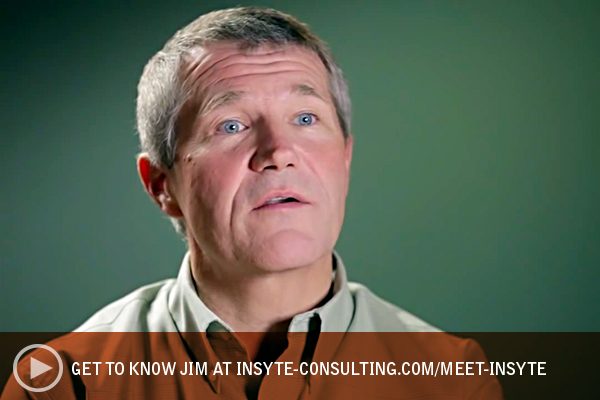In this issue of Insights, we talk with Jim Johnson about industrial engineering. With years of experience on the Insyte team, Jim has long been dedicated to helping area manufacturers improve their operations through instilling Lean practices and other modes of efficiency. Here, he discusses the role he plays on the Insyte team, with his clients and in the region’s manufacturing community.
Tell me what an industrial engineer does.
It’s not as simple an answer as you might think. An industrial engineer is a person who looks at a system—and that system could be a manufacturing process, a machining process; it could be a full assembly line; it could be an order entry process from a manufacturing standpoint—they look at that process or that system and analyze it to try to make it run better. We’re trying to make businesses run more efficiently, and make them more profitable, to be honest with you.
Can you discuss, using a hypothetical scenario, what’s involved in one of your projects?
One of our clients made a decision to relocate their manufacturing facilities from a rather cramped space to a larger facility. My role was to take a look at how they had been doing things, where the equipment is, for example, and with a clean sheet of paper, determine where it should be, with the idea that we want to make things a lot more effective.
We want to reduce the handling, the storage of the material; we only want to touch it once and then get it on its way. And we looked into different alternatives to do that, but we finally came up with a consensus on which was best suited to their needs.
Despite our best efforts, sometimes our work becomes inefficient over time. Why do you think that is?
I think people start off with the most efficient way to do things, and then additional responsibilities, additional things get added. For the client I mentioned, when they started, they put their machines in a line, so the sequences were A, B, C and D. Well, after time and the growth of their business, they expanded into other areas; they had to get more machines to actually produce the product for those areas, and they basically put it where they could. So what was common to them—moving materials from point A to point B within their current facility—over time was about doing the best they could with what they had. So when they moved into a new facility, we had the opportunity to say, “All right, how should this be?” And I think that’s where someone coming in from the outside, with a separate set of eyes, can help.
A common misconception—well, it’s more of an excuse, let’s say—is “it’s the way we’ve always done things.” Workers may understand that there’s a better way to do it, but at a certain point, they may not have the time or the sense of urgency to fix it.
Do you find there is fear within a team or organization to change what they’re doing?
Yes. I wouldn’t use the word “fear,” but there’s reluctance. When I’m talking to clients, I try not to use the word “change”; I try to use the word “improve.” So I’ll say, “How can we improve this system? Or this process? We want to reduce the scrap.” Well, in order to improve anything, intuitively, you’re going to have to change something in the process. I get them to think about improving things, rather than changing things. That kind of breaks down some of the barriers for people, who will say, “Yeah, that makes sense, I think I’d like to improve this. All right.” It gets them thinking about how they can do things a little bit differently to improve the outcome.
Why do you like working with the Insyte team?
We are all focused on insuring that the client gets what they paid for, and there are some measurable impacts at the end of the engagement. What we say, and what everyone at Insyte really believes in is what’s in the best interest of the client, and the mission of growing companies, small manufacturing companies here in WNY—that’s what we really believe in. If we can be a small part of making a particular company more profitable, well, we know it’s going to help everybody.

